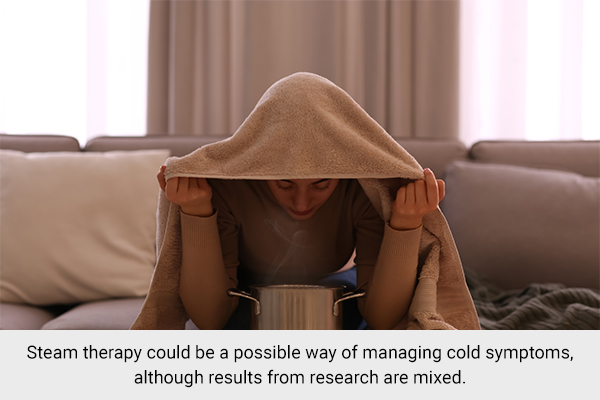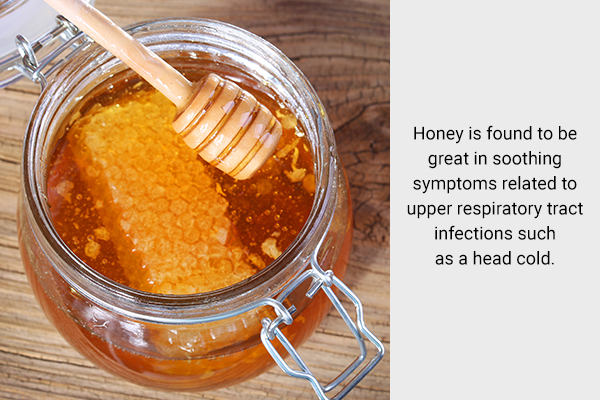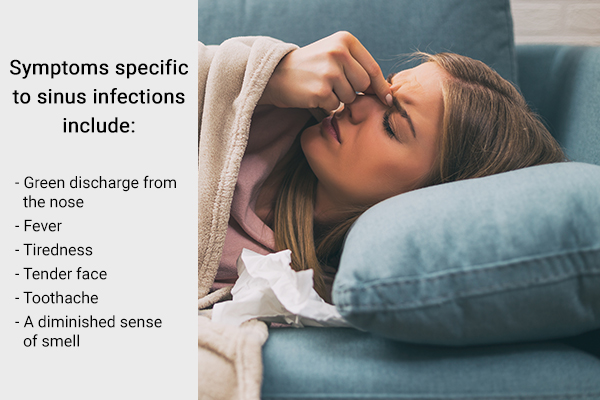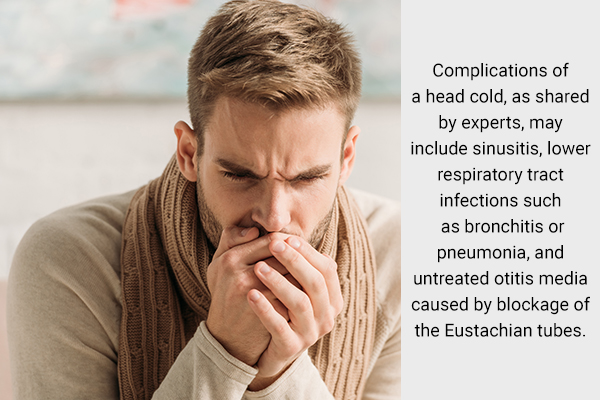In this article:
A head cold is a common household problem also known as a common cold. It is a viral infection of the upper respiratory tract. It is pretty harmless and symptoms resolve themselves within 2 weeks. (1)

The virus showcases symptoms in the throat and nose due to inflammation of the membrane lining in these body parts. The good news is that it is not a very serious condition, but only a mild illness.
However, it can have an impact on your everyday life due to symptoms such as: (2)
- Cough
- Sore throat
- Sneezing
- Lethargy
- Throat congestion
- Runny/stuffy nose
Furthermore, discharge from the nose that is usually green or yellow and appears after 24–48 hours can also be seen.
Note: A stuffy nose is a condition where the nasal passages are blocked or congested, making it difficult to breathe through the nose, while a runny nose is a condition where excess mucus is produced and flows out of the nose. Both can be a symptom or manifestation of a head cold.
The illness is communicable and spreads easily from person to person. Since the virus is airborne, it spreads rapidly when respiratory droplets from an infected person are transferred to a healthy person via a cough. (1)
Other modes of transmission are: (1)
- Contact with contaminated surfaces
- Sharing drinks or food with an infected person
- Kissing an infected person
- Skin-to-skin contact with an infected person
It will definitely come in handy to know some remedies for a head cold as a person can be expected to suffer from this condition two to three times a year. It is one of the most common illnesses.
In fact, in children, it can occur more easily, and most kids have it more than five times a year. (2)
How to Get Rid of a Head Cold
The popular belief that the common cold or head cold can be cured away easily with an antibiotic regimen is untrue.
As the name suggests, antibiotics kill living microorganisms such as bacteria and not viruses. Since viruses are responsible for causing the common cold, antibiotics may not be helpful for them.
Instead, you can take the following measures for faster relief and to feel better.
1. Take adequate rest

When you suffer from the common cold, you may feel weak, weighed down, and tired most of the time. You may even feel overcome by the condition, making you unable to get out of bed.
The best way to give the body its energy back is to take some much-needed rest. (2)
If you start to experience symptoms of the common cold, do not overexert yourself; try to stay at home and relax. It is good not only for you but also for others. This is because head cold spreads very easily.
Going out and about as if nothing is happening will make you a carrier of the disease to other healthy people. (3) It is your responsibility to stay safe and ensure others are safe too.
2. Drink plenty of fluids
Stay hydrated and drink sufficient water as fluids can be a great way to feel better when suffering from a head cold. This can include water and other healthy drinks.
Keep away from sodas, sugary drinks, colas, and even caffeinated drinks as these beverages can cause dehydration. It is also important to keep your distance from alcohol until you feel better at least. (3)
3. Soothe your throat
The common cold can cause a sore throat that can be very uncomfortable. Thus, it is important to soothe your throat to feel better.
There are multiple ways of doing so. Some of the most common ones are:
- Drink warm beverages such as tea or chicken soup, which is famously known to be given to those who feel under the weather. (4)(5)
- Take a hot shower (6)
- There are over-the-counter (OTC) throat lozenges that are helpful in treating sore throat. Suck on a lozenge to increase saliva production and ensure your throat is well-lubricated. (7)
4. Do steam therapy

Also known as steam inhalation, steam therapy could be a possible way of managing cold symptoms, although results from research are mixed.
To perform steam therapy, boil some water and carefully sit next to it while covering yourself and the pot of water with a cloth. Inhale the steam via your nose. The warmth of the steam loosens up the mucus in the nasal passages, providing symptomatic relief.
For increased effectiveness and a more soothing effect, you can add menthol to the boiling water.
Moreover, the steam moisturizes the irritated nasal passage, which is a common symptom of a head cold. This effect can help ease the throat pain and reduce the cough severity. (8)
5. Use a humidifier
A vaporizer or humidifier is a device that adds moisture to the air and increases humidity to prevent dryness. Dry air can be very irritating for your throat and nasal passages, especially if you suffer from the common cold.
Humidifiers are known to provide relief from respiratory symptoms of the common cold as they loosen the congestion and ease up coughing. These effects may help alleviate the discomfort you may feel if you have a head cold.
One study analyzed the prevalence of the influenza virus based on the relationship between absolute humidity and the survival rate of the virus. Results showed that absolute humidity may be a good predictor of virus survival rate in an environment. This is because humidity has been shown to be a good way to control the spread of viruses. (9)
Note: Absolute humidity is the measure of water vapor present in the air. Relative humidity is the ratio of the amount of water vapor present in the air to the maximum amount of water vapor the air can hold at a given temperature.
6. Try honey

Studies have shown honey to be a good ingredient to have when you suffer from a head cold. It acts as an efficient cough suppressant. It has also been found to be great in soothing symptoms related to upper respiratory tract infections such as a head cold.
Honey is rich in antioxidants and has antimicrobial properties that can potentially put up a good fight against common cold symptoms. It won’t cure you completely but will suppress coughing and ease throat pain.
You can have honey by mixing it in your daily tea; it not only makes your tea taste better but also helps control throat and nose symptoms when suffering from a head cold. Drinking honey with lemon tea is, in fact, a pretty common practice. (10)
Note: Honey may contain a paralysis-causing bacteria infants have poor immunity against, which is why it is not recommended for infants under the age of 12 months. According to scientists, infants under the age of 12 months have weak immunity to Clostridium botulinum, a probable honey contaminant that causes infant botulism.
Infant botulism can range greatly in severity, and its prevalence might be understated. Infants suffering from this condition experience abrupt muscle weakness or floppiness, which is frequently accompanied by feeding issues or constipation. It can also result in respiratory failure in severe cases. (11)(12)
7. Gargle with salt water
While movies and TV shows share a lot of absurd remedies to deal with health issues, saltwater gargling while sick is actually something you can include in your daily life.
Add half a teaspoon of salt to a warm glass of water and gargle every couple of hours. Doing so will help you manage the swelling, if any, and reduce the irritation in your throat. (3)
Head Cold Versus Chest Cold Versus Sinus Infection

Colds are infections of the respiratory tract that are caused by viruses. The difference between chest colds and head colds lies in the location of your symptoms or where in the body these symptoms are most pronounced.
For example, as the name suggests, a head cold involves head-related symptoms such as having a runny nose, red and watery eyes, and throat congestion. A chest cold, on the other hand, causes chest congestion accompanied by a cough.
Head colds and sinus infections have identical symptoms including runny nose, sore throat, and cough, but they occur due to different reasons. As discussed above, the common cold is caused by viruses, whereas sinus infections are mainly caused by bacteria and rarely by viruses. (13)
Symptoms specific to sinus infections include:
- Green discharge from the nose
- Fever
- Tiredness
- Tender face
- Toothache
- A diminished sense of smell
Complications and Management of a Head Cold

Complications of a head cold, as shared by experts, may include sinusitis, lower respiratory tract infections such as bronchitis or pneumonia, and untreated otitis media caused by blockage of the Eustachian tubes. (2)
For management, experts share that paracetamol can be used to alleviate systemic symptoms, but decongestants should not be administered to children under 6 years old, and children aged 6–12 years should take them for a maximum of 5 days only.
Experts also explain that acute common cold is the most common upper respiratory tract infection, and antibiotics are only prescribed for secondary infections as the common cold is caused by viruses, not bacteria. (2)
It’s worth noting that while the flu vaccine can help prevent the flu, it does not protect against colds. (2)
Here are some tips to prevent a case of a head cold: (3)
- Avoid contact with people who suffer from a common cold.
- If you accidentally touch a contaminated surface, wash your hands properly.
- Do not touch your face with your hands to avoid the transmission of germs.
- Do not share utensils, sheets, or towels with an infected person.
Maintain good health with a well-balanced diet to build up immunity against such infections.
When to See a Doctor
Head colds usually resolve by themselves in a few days and do not require many interventions. However, experts suggest you should see a doctor if symptoms worsen such as:
- Inability to breathe
- A very high fever (101°F)
- Unmanageable headache
- Uncontrolled coughing
- Rashes
- Confusion
- Pain in your ears
If you have a chronic medical condition such as diabetes or heart, lung, or kidney ailment or you are undergoing chemotherapy, a deterioration in your symptoms should be taken seriously.
If your child is under 3 months old and exhibiting signs of fever or lethargy, prompt medical attention is recommended. You should also seek medical help if symptoms don’t show any improvements even after a week.
How Are Sinus Infections Diagnosed?
A type of X-ray called the “Waters’ view” is a cheap and easy way to check how bad the swelling is in your sinuses. Doctors use it a lot to quickly see if there’s a problem. (14)
Final Word
Head colds don’t really have a particular cure, so prevention is always better. They should not be taken very lightly if they seem to worsen or do not show any improvement even after a week.
Head colds can lead to complications such as bronchitis or pneumonia, which are pretty serious infections.
- Was this article helpful?
- YES, THANKS!NOT REALLY


